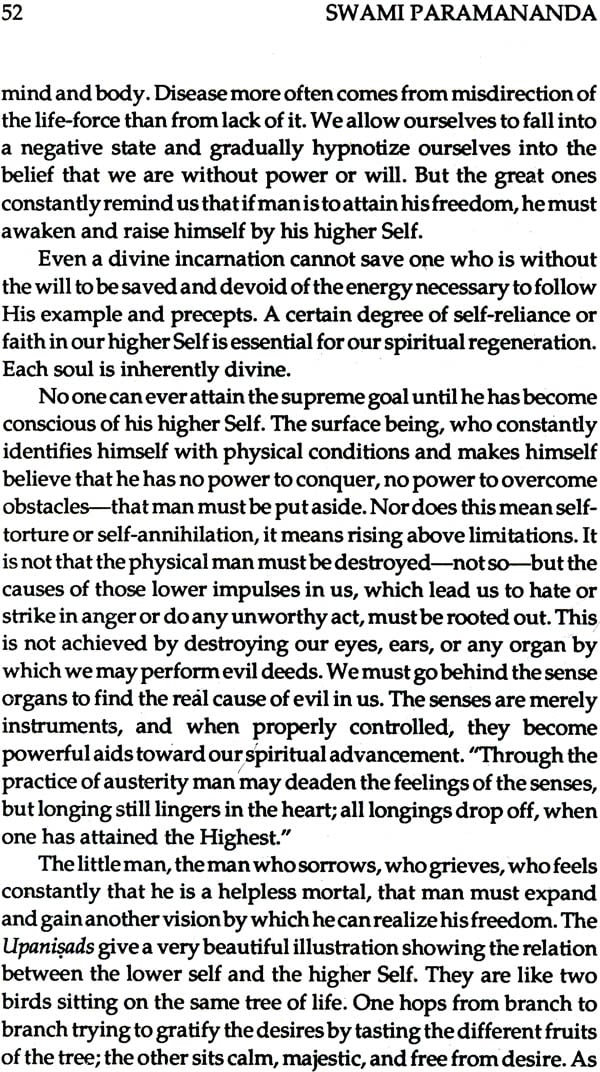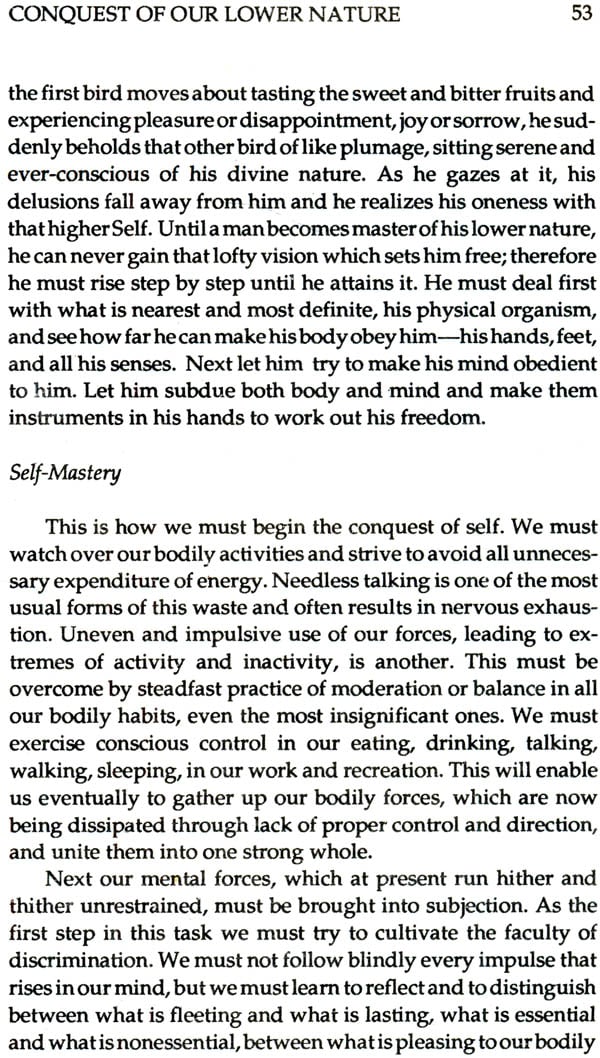
The Razor?s Edge
Book Specification
| Item Code: | NAF190 |
| Author: | Rudolf Bikkers |
| Publisher: | Central Chinmaya Mission Trust |
| Language: | English |
| Edition: | 2001 |
| Pages: | 94 (5 B/W Illustrations) |
| Cover: | Paperback |
| Other Details | 8.5 inch X 5.5 inc |
| Weight | 120 gm |
Book Description
Spiritual teachers have likened the path of a seeker to the sharp edge of a razor, for walking straight and true along the path of inner unfoldment requires constant vigilance. Alert and honest watchfulness is in itself a spiritual practice. How to develop that vigilance over ourselves is the subject matter of The Razor's Edge. In these pages the authors give us practical hunts and methods of "treading the path" as smoothly as possible. Since the mind is a delicate instrument, careful handling is advised. The authors point out that:
The purification of the mind and control over the sense organs is essential.
One must be able to clearly differentiate between suppression and sublimation.
The development of one's personality cannot be hurried or forced.
No matter where we are in our development there is a way for everyone provided we have enough courage and willpower to pursue it.
By applying the wisdom of the author's words to our lives we begin to experience an inner transformation. If carefully nurtured this inner growth results in a mind that is fully capable of progressing unhindered towards the goal of spiritual self-unfoldment.
When one discovers something profound and beautiful, the natural tendency is to share it with others. The ancient Indian sages were no exception. After having perfected themselves they saw perfection everywhere. Their call to us is to "arise and awake." But what exactly do these two terms mean.
The "arising" or discrimination begins when we have perceived clearly through repeated experience with the world-of-objects that complete fulfillment is never found in them. Only when we get a succession of sharp kicks from life do we ask the question : Is there something more than this ? We have one option left - to turn away from our preoccupations with the world and turn inward ourselves. Yet it is difficult in the beginning to withdraw the mind from its fascination with objects. The mind needs to be convinced of its fascination with objects. The mind needs to be convinced of its true nature, the pure Consciousness. A master helps to bring about that "awakening".
For many years we have misusing the body, mind and intellect. They need to be returned, refined, reawakened. To fine tune ourselves is to live the spiritual life.
Yet how do we begin ? There are many methods of self development and paths of spirituality. One common thread in all of them, however, is an emphasis on moral and ethical living. Why is this so ? Vedanta teaches us uncompromisingly that real concentration and discrimination can not take place when the mind is full of agitation. Only in the remastering of our minds and sense organs can lasting happiness and peace of mind be gained.
To constantly practice awareness, self-control, and self-discipline is not easy. Because our identification with the body and mind is very strong, it would be foolish to suddenly demand a halt to all desires. This would very likely lead to suppression. If, on the other hand, we practice self-discipline, while at the same time learn more about our true nature, we expand our-selves gradually and naturally. This is sublimation. To maintain this constant vigilance and surveillance over ourselves is what is meant by "the path is as the razor's edge."
Sometimes in our - anxiety to reach the goal we try too hard. The word tapas, which has been translated as austerity and self-denial, actually means applying one's whole being -body, mind, and intellect - to the attainment of the main purpose of life, namely, Self-realization. If those words, austerity and self-denial are taken too literally, however we can end up with an inflexible personality.
Some of us tend to feel frustrated when we cannot lives up to the ideals all the time. Therefore along with courage and self-confidence, we must also have compassion and patient with ourselves. In the natural development of our personalities there can be no hurry; the bud gradually opens into the flower, and the fruit ripens of its own accord. Haste makes waste in all these cases. Through hearing, reflecting and contemplating our true Self will slowly be revealed to us: The importance we give the objects of the word will gradually lesson and eventually subside. It is then that we can properly apply ourselves to the quest for the discovery of our real nature.
In this issue, the different authors provide us with clear methods and hints of how to walk the path of spirituality. In part One, "Finding the Way", the psychoanalyst Rollo May begins by saying that we must have courage to be able to see the truth and that it is rare to find a real lover of wisdom. Swami Chinmayananda then analyzes the different mental conditions and points out a method of every type of seekers. Mimi Frazer beautifully blends the Eastern and Western approaches to spirituality.
Part Two, "Obstacles Along the Way", emphasizes that our greatest enemy is indeed ourselves. Vimla Thakar shows as that by stilling our mind, our relationship with ourselves and others will immediately improve. Gerald Heard, English writer and lecturer, tells us in a delightful story how our social weaknesses can impede our higher urges. Swami Paramananda, a disciple of Swami Vivekananda, writes that our real conquest lies in mastering ourselves, reminding us of Jesus ' saying : "For what does it profit a man, if he gains the whole world but suffers the loss of his own soul."
Part Three suggests ways and means of "Maintaining the Balance." Eknath Easwaran, Vedantic writer and lecturer, recommends practicing various disciplines simultaneously so that spiritual living can become a total way of life. Swami Chinmayananda exhorts us to keep vigilant, "since even a man well versed in book-knowledge will forget his divine nature it his attention is turned towards the sense-objects." How a young Zen priest should live and practice in the world is extensively told by Eugen Herrigel, a German professor who became a Zen mystic. The issue concludes with Swami Chinmayananda's call to commit ourselves completely to the goal.
| Preface | 1 | |
| Part One : Finding The Way | ||
| I | The Virtue of Courage | 8 |
| Courage to see the Truth | 9 | |
| Discovering Truth | 11 | |
| II | Many Ways to the Goal | 14 |
| Preparing for Contemplation | 17 | |
| Yoga of Constant Practice | 20 | |
| Yoga of Action | 20 | |
| Renouncing the Fruits of Action | 22 | |
| III | The Path to Reality | 24 |
| The Universal Goal | 25 | |
| Renewing the Mind | 26 | |
| Various Practices | 28 | |
| Part Two : Obstacles Along The Way | ||
| IV | The Pitfalls of the Mind | 36 |
| The Dangers of Ideation | 37 | |
| Comparison Breeds Discontent | 40 | |
| Accepting Life | 41 | |
| V | The Inner Voice | 43 |
| The Enticement of Wealth | 45 | |
| The Social Reformer | 47 | |
| VI | Conquest of Our Lower Nature | 50 |
| Faith in Our Higher Self | 51 | |
| Self-Mastery | 53 | |
| Part Three : Maintaining The Balance | ||
| VII | The Interrelationship of Spiritual Disciplines | 60 |
| Meditation | 62 | |
| Repetitions of the Mantram | 63 | |
| Slowing Down | 64 | |
| One-Pointtedness | 65 | |
| Training the Senses | 66 | |
| Putting Others First | 68 | |
| Reading in Mysticism | 69 | |
| Association with Like Minded People | 70 | |
| VIII | How to Retain Godhood | 71 |
| Ego Reasserts Itself | 71 | |
| Don't Look Back | 73 | |
| Constant Remembrance | 76 | |
| Directing the Mind | 80 | |
| IX | Zen in Practical Life | 81 |
| Finding Balance | 83 | |
| An Ideal Example | 84 | |
| The Abiding Love | 88 | |
| X | Commitment to the Ideal | 91 |
| Turning Within | 92 |







